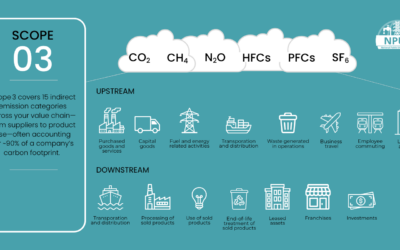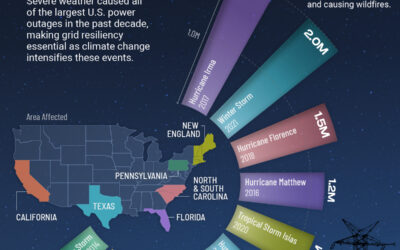The Flow of Energy-Related CO2 Emissions in the U.S.
In 2021, U.S. carbon dioxide emissions from the generation and consumption of energy reached 4.9 billion tonnes. Fossil fuels including petroleum, natural gas, and coal made up 100% of these emissions.
To better understand how various energy sources and their end-uses contribute to carbon emissions, this graphic sponsored by the National Public Utilities Council visualizes the flow of energy-related CO2 emissions in the United States.
What Are Energy-Related CO2 Emissions?
Energy-related CO2 emissions refer to the release of carbon dioxide as a result of the combustion of fuels to produce energy. They arise through the direct use of fossil fuels for transport, heating, or industrial needs, as well as the use of fossil fuels for electricity generation.
In addition to the emissions that arise from the generation and consumption of energy, there are several other ways CO2 emissions can arise. To provide some context, they can result as a byproduct of industrial chemical reactions, deforestation, and agricultural activities.
As the largest contributor to carbon emissions, however, energy-related CO2 emissions account for approximately 85% of all emissions in the United States, which we will now explore in further detail.
U.S. Energy-Related CO2 Emissions in 2021
Followed by a pandemic-driven decline in 2020, energy-related CO2 emissions in the U.S. increased by 325 million tonnes in 2021, marking the largest-ever annual increase. Clean energy sources, namely solar, wind, nuclear, biomass and hydropower, accounted for 0% of these emissions.

When we follow the CO2 emissions from the above fossil fuels to their end uses, transportation and electricity generation stand out as the biggest contributors.
In 2021, these two sectors accounted for more than 68% of all energy-related emissions in the country, roughly emitting 3.3 billion tonnes of CO2.

When it comes to transportation, petroleum accounted for 97% of emissions, largely due to motor gasoline and diesel consumption. On the other hand, coal and natural gas made up 99% of CO2 emissions related to electricity generation.
Due to its high carbon intensity, coal’s contribution to power sector emissions is of particular interest. As the share of coal rose from 20% to 23% in the U.S. electricity mix in 2021, electricity emissions from coal also increased for the first time since 2014.
Naturally, this shift raised the overall energy-related CO2 emissions in 2021. It also caused a 4% hike in the carbon intensity of the country’s electricity, hinting at the urgent need for a shift away from coal.
The Path to Decarbonization: Lowering Emissions
The impact of climate change has become increasingly clear in recent years. To avoid its worst impacts, it’s essential to achieve decarbonization across all sectors, which requires significant reductions in energy-related carbon emissions.
One of the most critical sectors for emissions reductions is transportation, which accounts for nearly 40% of all energy-related CO2 emissions. The good news is that there is enormous potential to reduce these emissions through the use of electric vehicles and the decarbonization of the electricity used to charge them.
To decarbonize the power sector, the U.S. must transition away from fossil fuels and towards clean energy sources such as wind, solar, and nuclear power. Once achieved, decarbonized electricity also has the power to reduce emissions from all other sectors that use electricity, including industrial, residential and commercial activities.
By taking bold action toward these objectives, the U.S. can accelerate the transition to a clean energy future within its borders and beyond.




